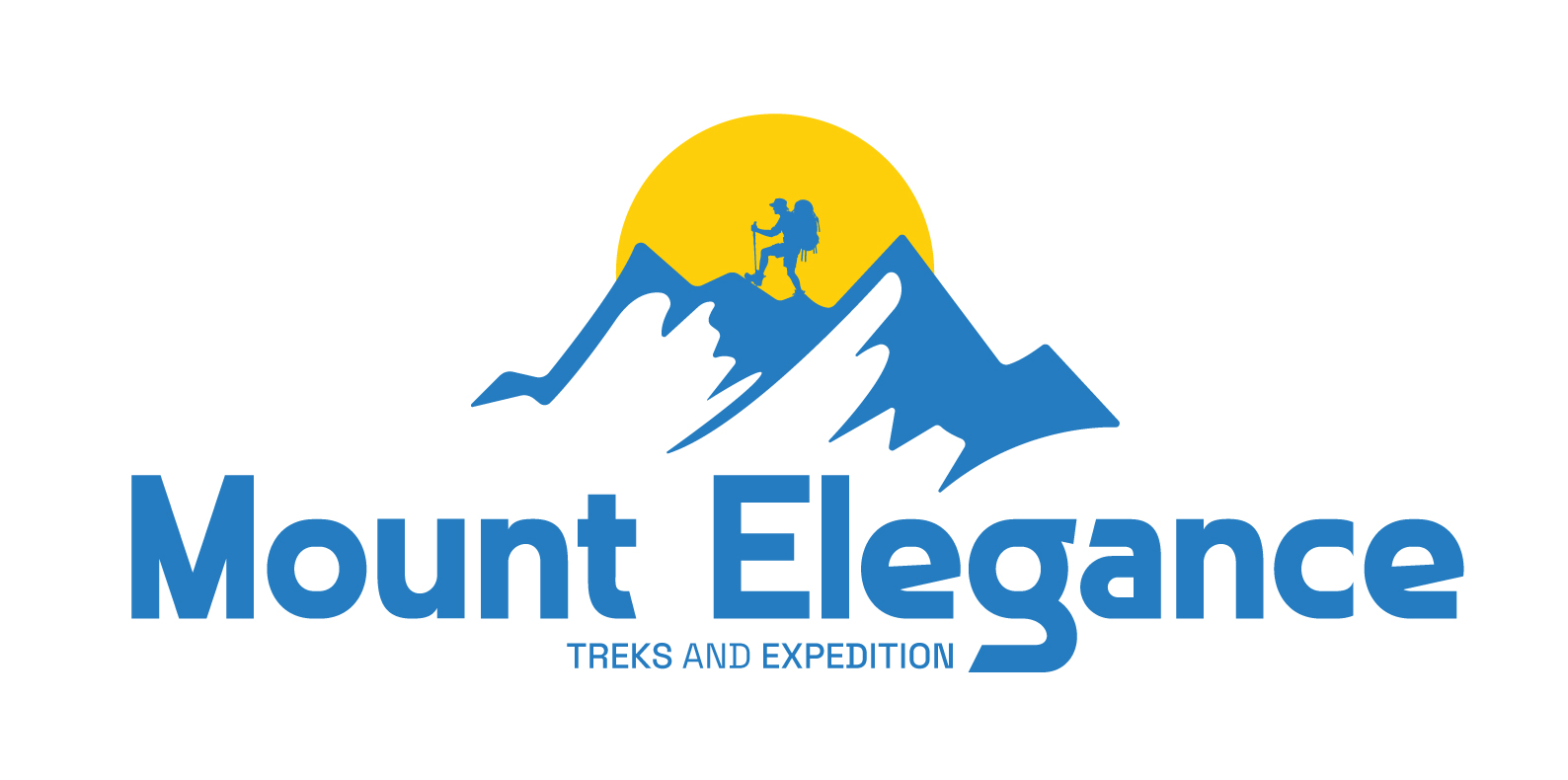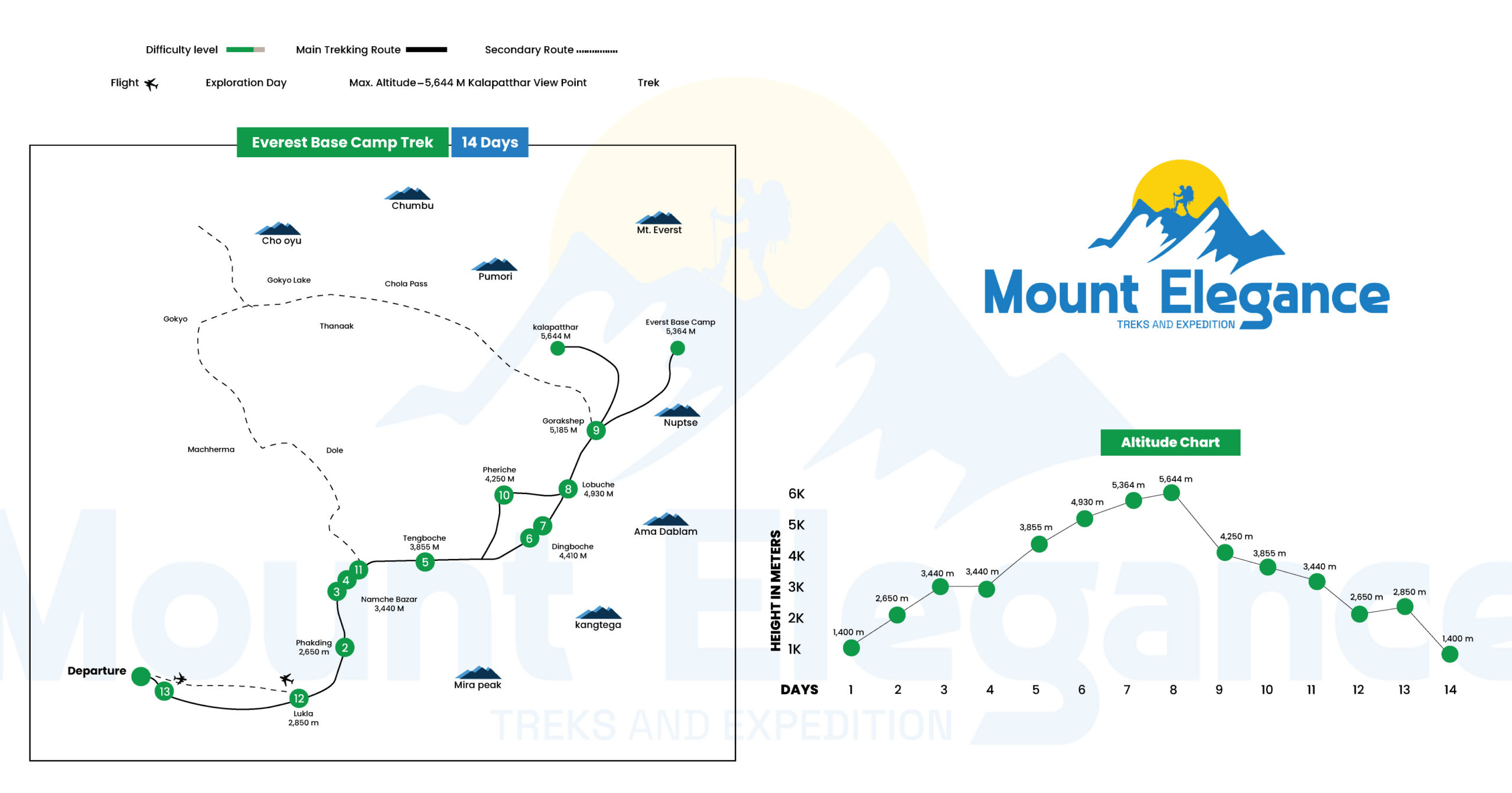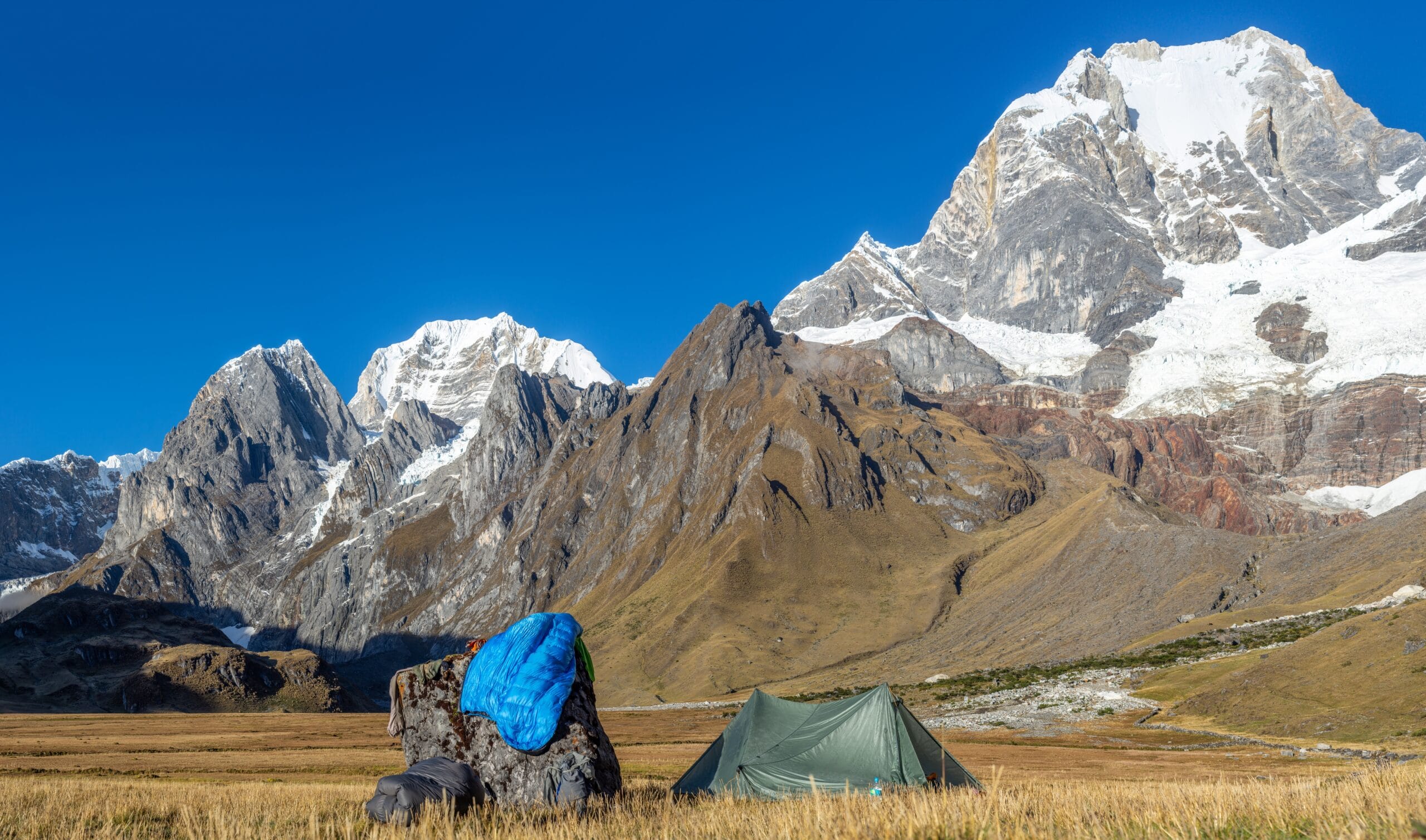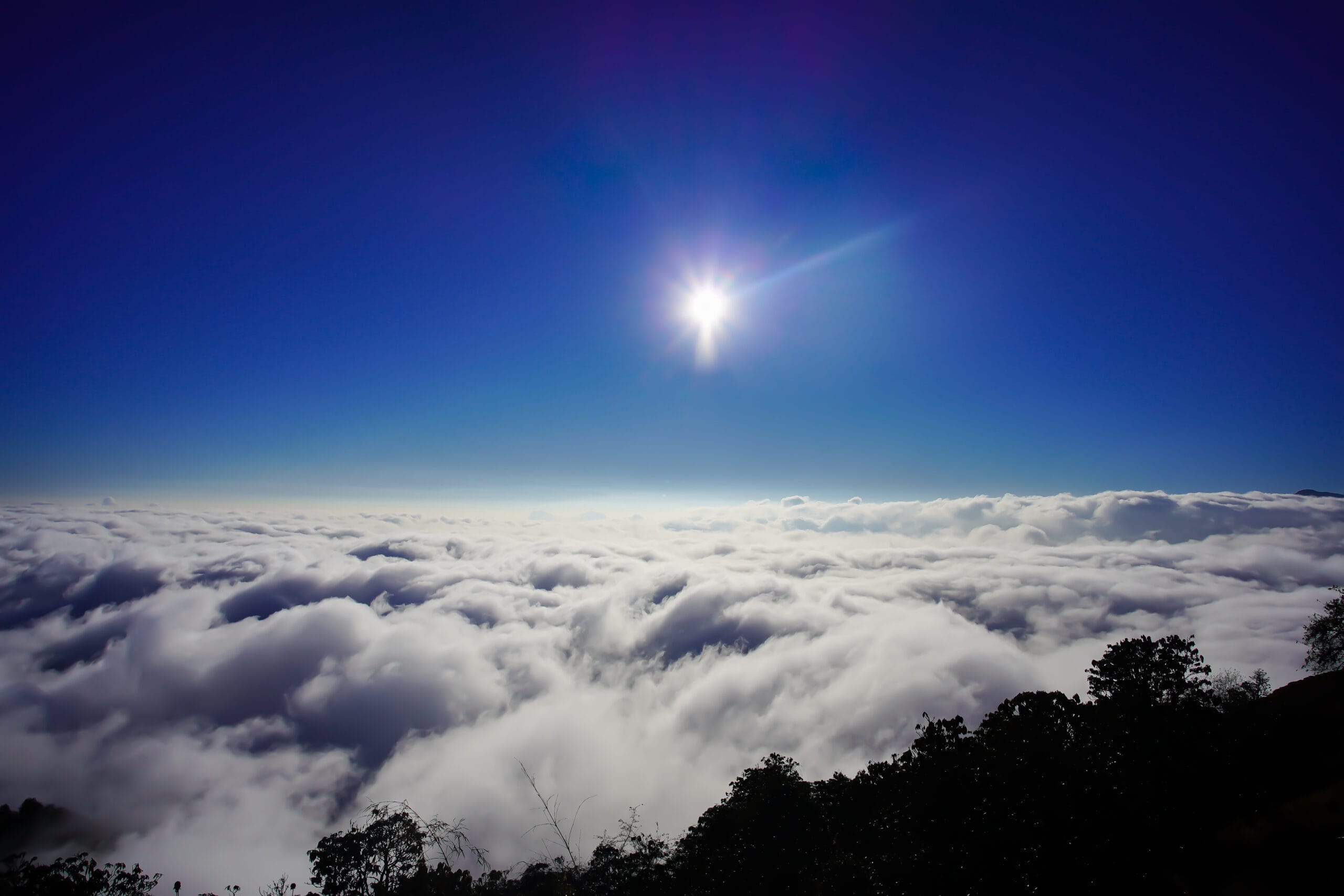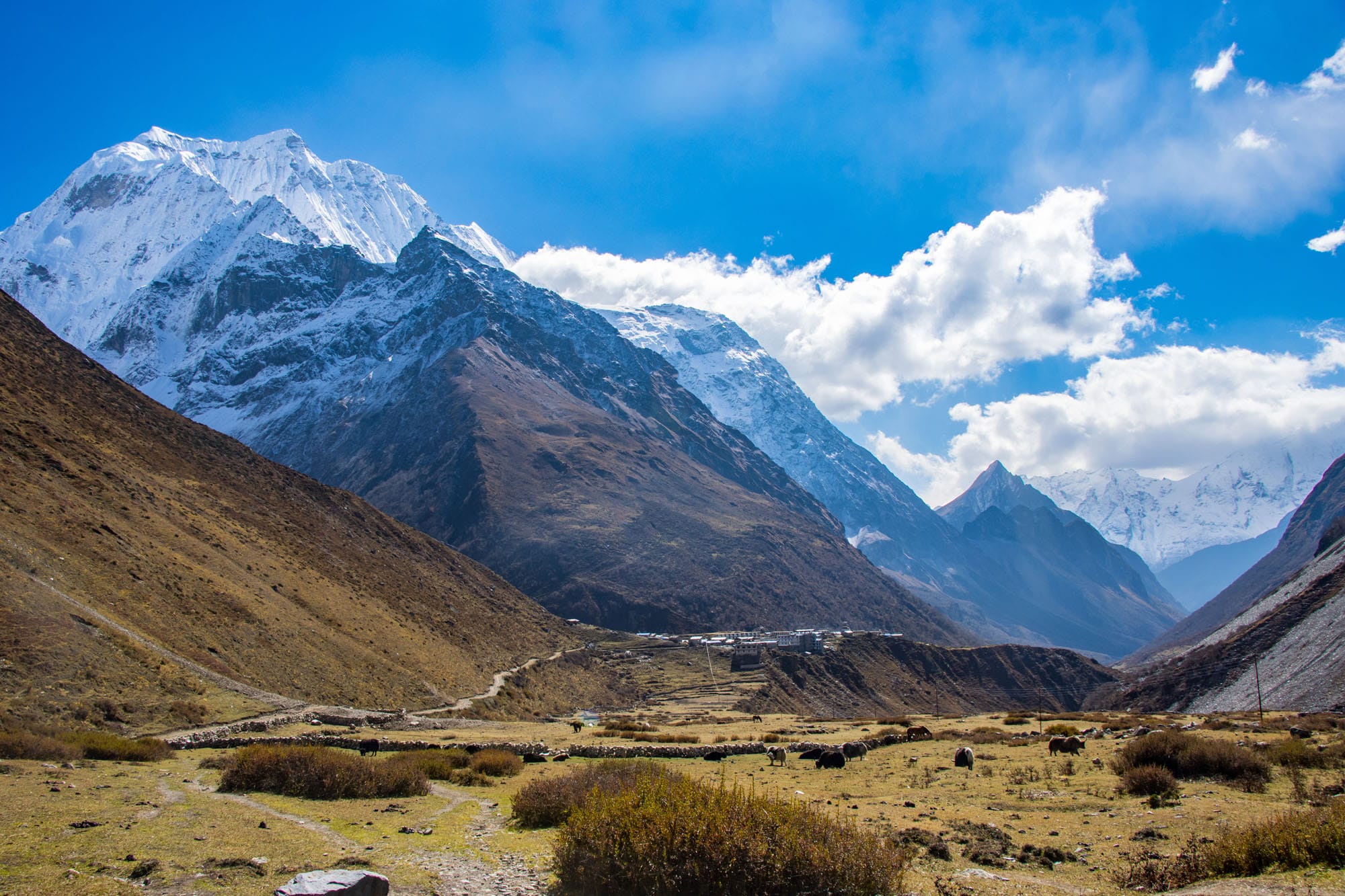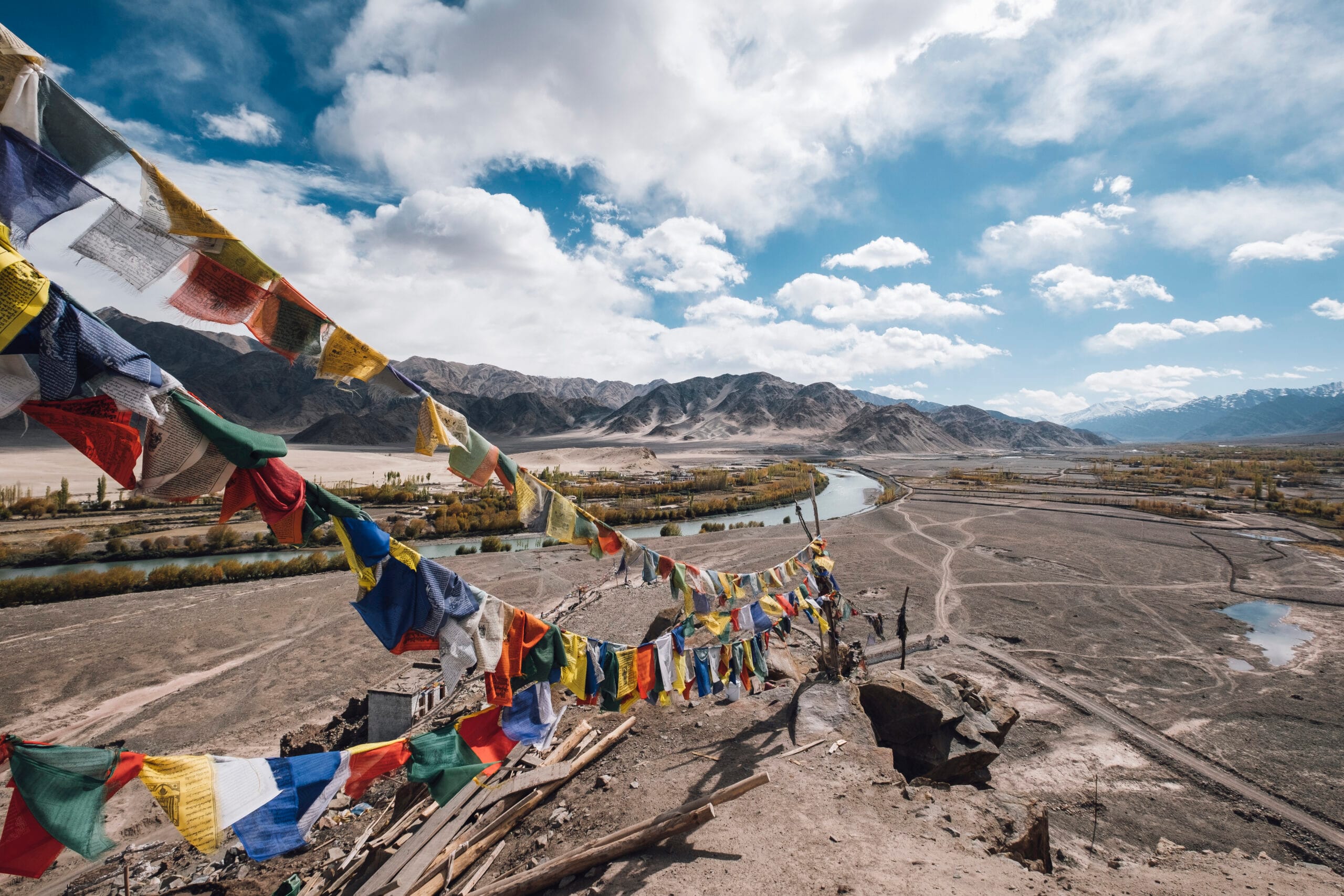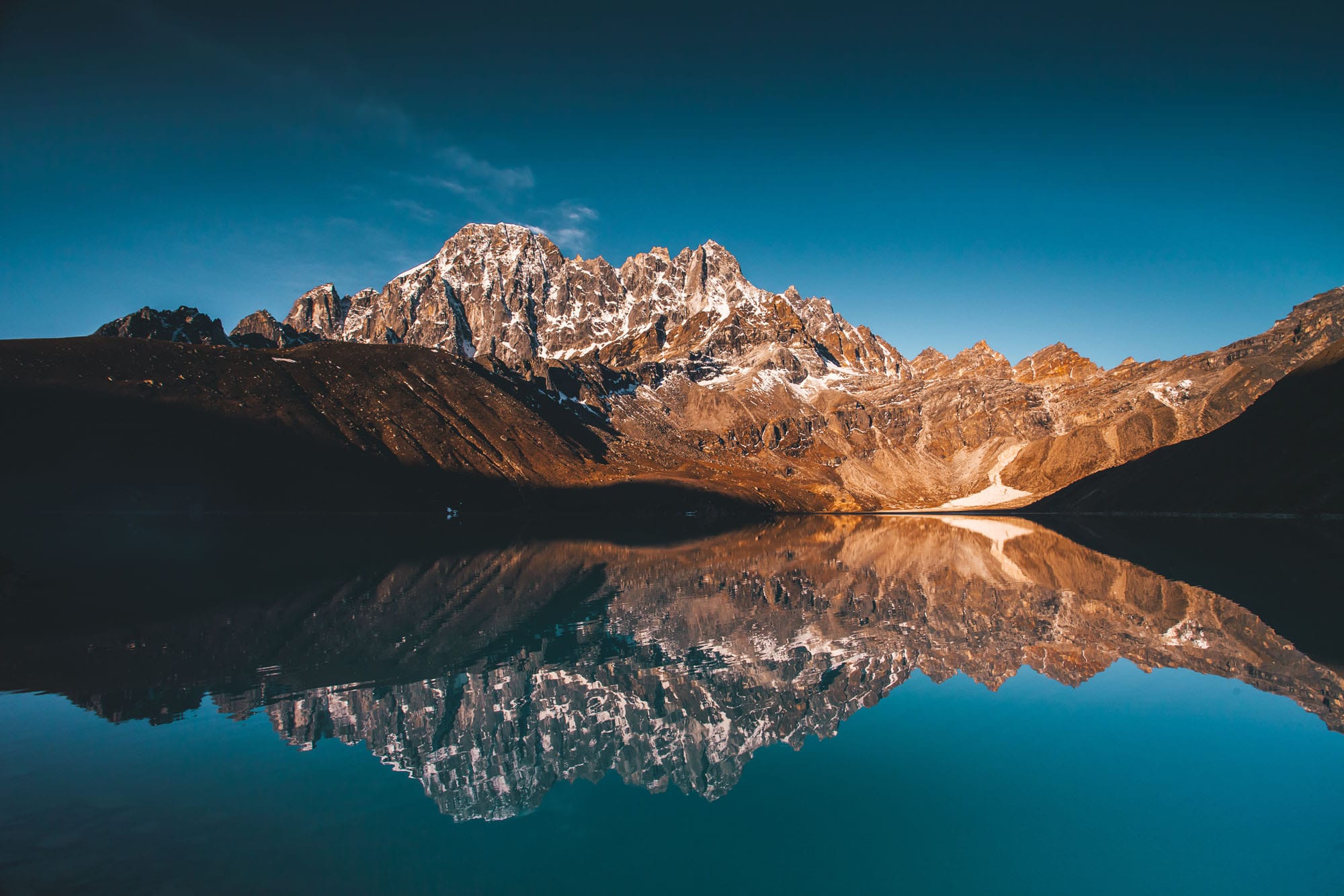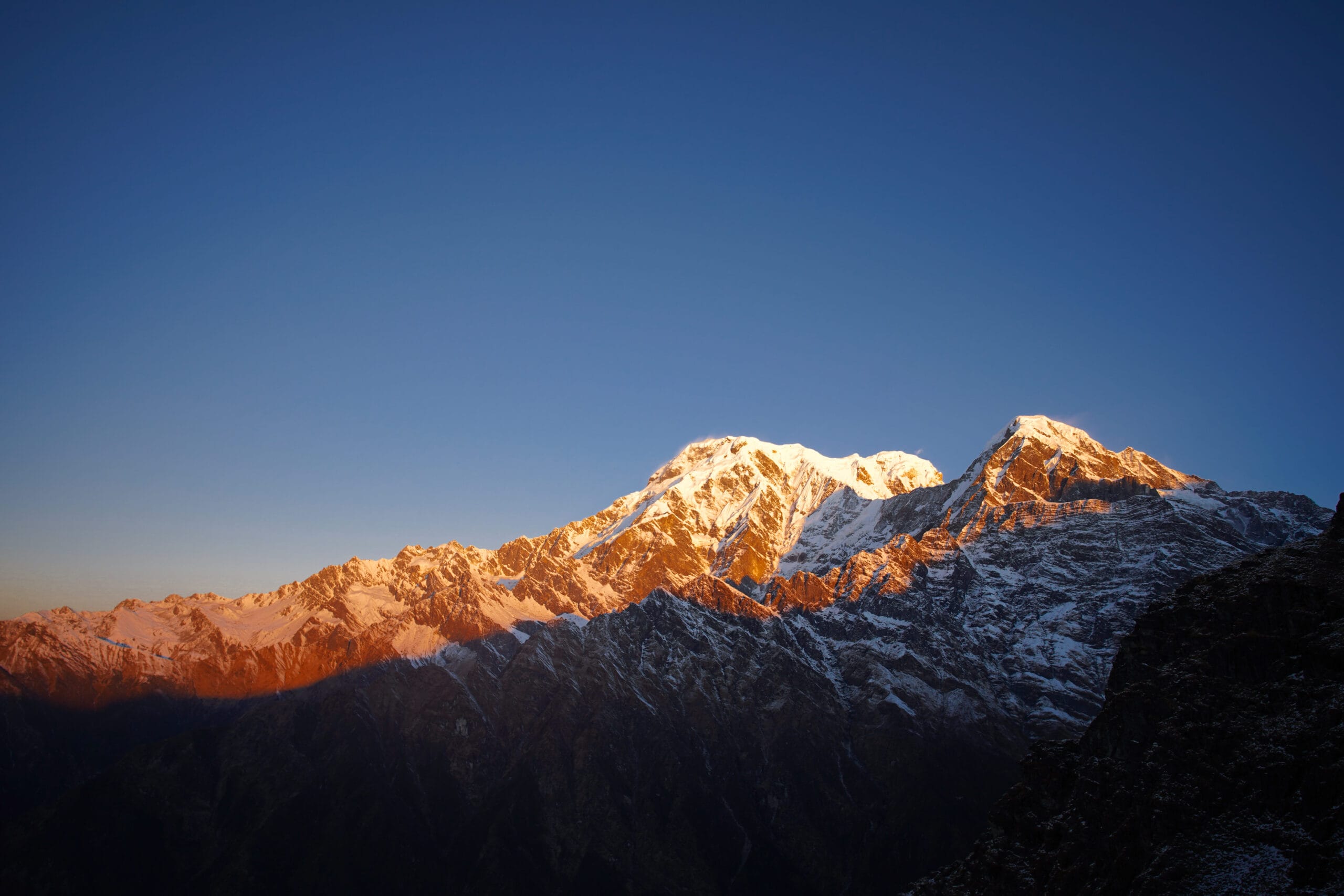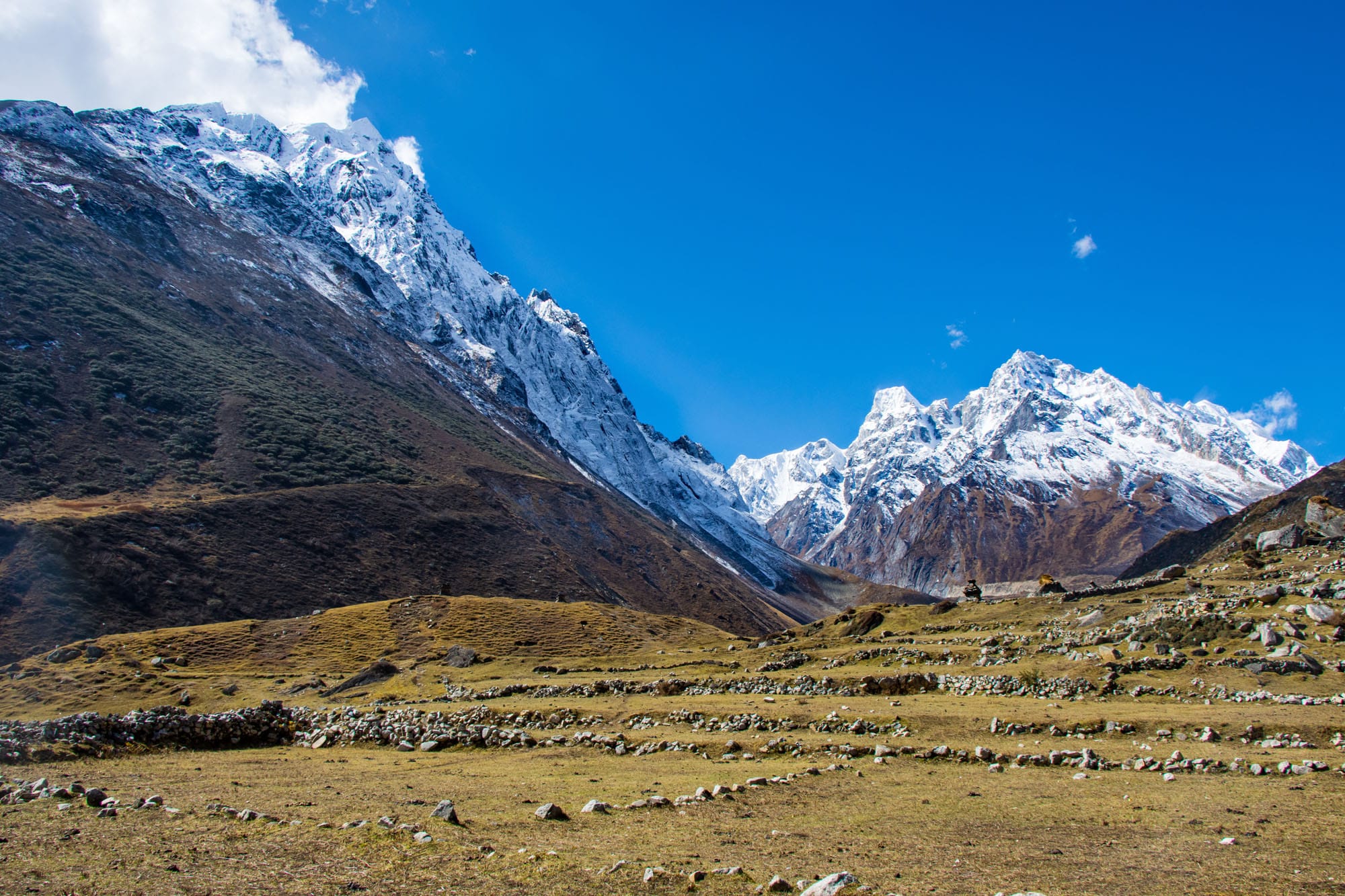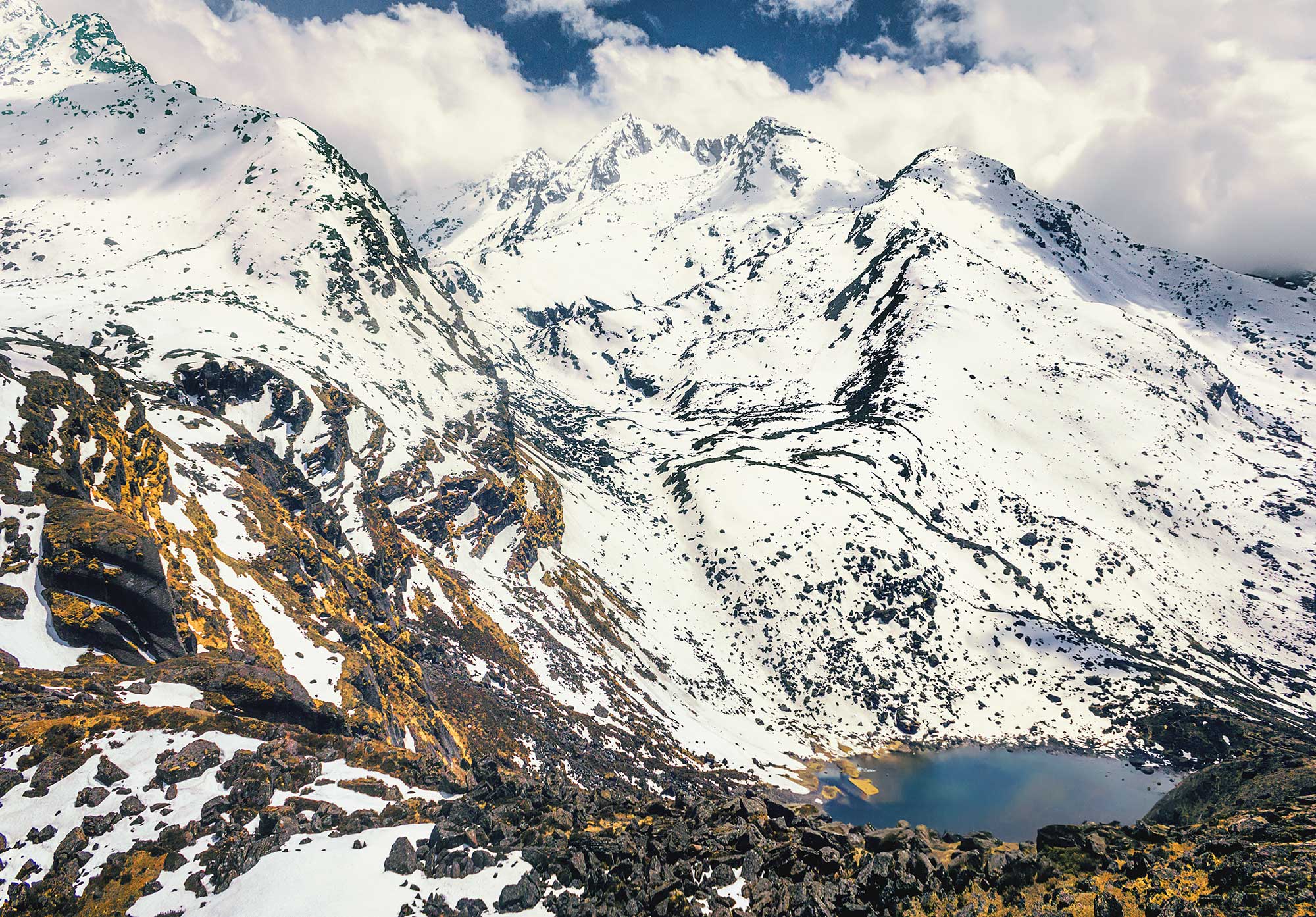Everest Base Camp Trek – 14D
Best Season
Highest Altitude
Trip Overview
The Everest Base Camp Trek is an iconic adventure that attracts trekkers from around the world. Many come eager to experience the unmatched grandeur of the Himalayas among many treks in Nepal. The Everest Base Camp Trek journey immerses you in the stunning beauty of the Khumbu region. Here, you’ll witness panoramic views of Everest and its towering neighbors. The adventure begins with a scenic flight from Kathmandu to Lukla. This flight sets the stage for the remarkable best trek ahead.
As you move along the trail, the hike to Everest Base Camp trek leads you through picturesque Sherpa villages and verdant forests. The rugged alpine terrain adds to the sense of adventure. With each step, you draw closer to the legendary base camp of the world’s highest peak. Along the way, you will trek through Sagarmatha National Park. This UNESCO World Heritage Site is home to diverse flora and fauna. Moreover, the cultural richness of the region is equally captivating. You’ll experience the warmth and hospitality of the Sherpa people. Their traditions and way of life have remained largely unchanged for centuries.
One of the highlights of the entire trek is a visit to Tengboche Monastery. It is the largest monastery in the Khumbu region of Nepal. Here, you can soak in the spiritual atmosphere while surrounded by the Himalayas. The journey culminates at Everest Base Camp, standing at 5,364 meters. The sense of achievement you feel here is profound. However, the adventure doesn’t end there. A climb to Kala Patthar (5,644 meters) offers a panoramic view of Mt. Everest and the surrounding peaks. This climb provides a perfect finale to this unforgettable trek.
Trip Highlights
- Scenic flight from Kathmandu to Lukla.
- Trekking through Sagarmatha National Park, a UNESCO World Heritage Site.
- Experiencing the culture and hospitality of the Sherpa people.
- Stunning views of Everest, Lhotse, Nuptse, and Ama Dablam.
- Visit to Tengboche Monastery, the largest monastery in the Khumbu region.
- Reaching Everest Base Camp at an altitude of 5,364 meters.
- Climbing Kala Patthar (5,644 meters) for a panoramic view of Mount Everest and the surrounding peaks.
- Accommodation: Stay in comfortable teahouses during the trek and standard hotels in Kathmandu.
- Meals: Full-board meals (breakfast, lunch, and dinner) during the trek; breakfast in Kathmandu.
- Luggage: Porters provided for luggage transport (up to 15 kg per person).
- Internet/Wi-Fi, electricity, and water are generally accessible at most lodges on the hiking path; however, extra fees could be tacked on. Complimentary Wi-Fi is offered at hotels across Kathmandu.
This trek offers not just a physical challenge but also a journey through one of the world’s most spectacular landscapes.
A dependable trek guide significantly enriches the Everest Base Camp experience. This is especially true during the prime trekking season, when the goal is to reach base camp. The journey is a memorable one, following a carefully planned Everest Base Camp trek schedule.
Mount Everest is the focal point of this strenuous, high-altitude hike. Despite the difficulty of the climb, the walk is well worth it because it takes an additional day to adjust and requires a valid trekking permit. Many consider the ascent to Everest Base Camp to be the pinnacle of trekking adventures.
Mount Everest is the focal point of this strenuous, high-altitude hike. Despite the difficulty of the climb, the walk is well worth it because it takes an additional day to adjust and requires a valid trekking permit. Many consider the ascent to Everest Base Camp to be the pinnacle of trekking adventures.
The famous Everest Base Camp hike, also called the Mount Everest Base Camp trek, takes 12 days to complete. You won’t have to go over any tough passes to get to Namche Bazaar and Phakding. You’ll also have a professional guide with you as you hike through a beautiful area.
Your trip to Everest Base Camp, also known as a trek to EBC, makes sure that you get to base camp at the end of a day’s worth of trekking. This is possible with a well-organized Everest Base Camp trek plan that you can enjoy while you’re trekking and that has a clear trip cost.
This EBC trek in Nepal helps you pick the best time to hike to Everest so you can do the hike safely and finish at Everest Base Camp for the best experience. The trek starts in Nepal’s Khumbu area and follows the well-known Everest Base Camp path. Each day of hiking shows you what the trek has to offer.
This high-altitude trek also appears as the 14-day Everest Base Camp route, and along the Everest Base Camp path you’ll trek to Tengboche. Many people choose the Everest Base Camp Trek 14, also called the Base Camp Trek 14 Days. To start the trek, you have to get an entry ticket for Nepal and walk to Lobuche. Then you spend a few days in Namche before you reach the base camp of Mount Everest.
Every day of the trek takes you closer to base camp. Along the way, you’ll see the famous “gateway to Everest,” which gives you stunning views of the mountain. The trek starts with flights to the Everest area. The whole trip, including the beautiful hike to Everest Hotel, is planned to happen at what is thought to be the best time to reach Everest Base Camp.
Essential Items:
- Base Layers: Thermal top and bottom
- Insulation: Fleece jacket and down jacket
- Outer Layer: Waterproof jacket and pants
- Trekking Clothes: Some pairs of trekking pants, quick-dry shirts
- Footwear: Trekking boots, camp shoes/sandals
- Headwear: Sun hat, warm hat, neck gaiter
- Hand-wear: Lightweight gloves, insulated gloves
Items to bring: sunglasses, lip balm, sunscreen, a headlamp with extra batteries, hiking poles, a 50–60 L backpack, and a daypack.
Personal Items: Include quick-drying towels, toothbrushes, toothpaste, and wet wipes for cleaning up. It has a capacity of 2 liters and treats (like nuts and energy bars)
Medical Kit: Personal medications, basic first aid, altitude sickness pills
Documents: Passport, trekking permits, travel insurance
Optional: Camera, power bank, Lightweight sleeping bag
Lukla Flight and Cancellation:
One of the most exciting parts of Everest trekking is the flight to Lukla, which is the gateway to the Everest area. Depending on the time of year to hike and the rules for flying, these flights to the Everest area usually start from either Kathmandu or Ramechhap.
Lukla flights are very sensitive to weather because they are so high up, and the weather in the mountains is hard to predict. During the monsoon and winter seasons, flights are often delayed or even stopped.
Experts strongly advise hikers to think carefully about when they embark on their trek. They should also factor in an extra day or two when arranging their Mount Everest Base Camp journey, just in case their flights get delayed. Should a cancellation linger, helicopter charters might be arranged.
However, these would include an additional fee, apart from the first trek’s expense. Booking your trip with Mount Elegance Trek and Expedition means you can relax. We keep a close eye on flight times and weather reports to keep you updated and help you make other plans if needed.
Itinerary
- Drive Duration: 30-45 minutes
- Meal: Breakfast
- Highest Altitude: Kathmandu (1,400 m/4,600 ft)
Your Himalayan journey begins the moment you are at Tribhuvan International Airport in Kathmandu. Once you've cleared immigration, a representative from our trekking organization will greet you and take you to your hotel.
The bustling capital of Nepal offers a vibrant mix of traditional culture and modern amenities. Depending on when you get here, you could choose to unwind at your hotel or head out to Thamel. It's a well-known spot for visitors, packed with vibrant shops, cafes, and places to dine.
Later, you'll sit in on a pre-trek briefing led by your guide. This guide will provide you with all you need to know for your Everest Base Camp trek in Nepal. We'll cover safety measures, gear checks, and what you can expect about altitude acclimatization. This is a great time to meet your fellow trekkers and ask any last-minute questions. The evening can be spent enjoying a delicious Nepali dinner or simply resting up for the adventure ahead.
- Flight Distance: 138 km (86 miles)
- Flight Duration/Trek Duration: 25-30 minutes / 3-4 hours
- Meal: Breakfast, Lunch & Dinner
- Highest Altitude: Lukla (2,860 m/9,383 ft) & Phakding (2,610 m/8,563 ft)
An early morning scenic flight takes you from Kathmandu to Lukla, the gateway to the base camp region. The short 25 to 30-minute flight is nothing short of thrilling, with stunning aerial views of terraced fields and towering peaks. Upon arrival at the Tenzing Hillary Airport in Lukla, you’ll meet your porters and begin your trek. The trail from Lukla descends gradually through pine and cedar forests, with views of Himalayan peaks in the distance.
After crossing suspension bridges and winding through charming Sherpa villages, you'll reach Phakding. This small, riverbank settlement is tucked away in the Dudh Koshi Valley. The trek on this day is relatively short, allowing you to begin acclimatizing for the extra day. You can take a walk around the village, visit local monasteries, or relax by the river as you prepare for the next day’s journey.
- Trek Distance: 10 km (6.2 miles)
- Trek Duration: 5-6 hours
- Meal: Breakfast, Lunch & Dinner
- Highest Altitude: Namche Bazaar (3,440 m / 11,283 ft)
After breakfast, you’ll set off on a scenic and slightly more demanding trek to Namche Bazaar. The trail goes next to the Dudh Koshi River and crosses several hanging bridges. One of these is the Hillary Suspension Bridge, which is decorated with colorful prayer flags. You’ll pass through villages such as Monjo and Jorsalle, where the entrance to Sagarmatha National Park is located. Here, permits will be checked before continuing on the trail.
The last climb to Namche is a tough uphill walk through a pine forest, but on a clear day you can see Mount Everest and Lhotse for the first time. As you arrive in Namche Bazaar, you’ll find yourself in the vibrant heart of the Khumbu region. This amphitheater-shaped town is full of shops, bakeries, gear stores, and teahouses. It’s also a key trading post for Sherpas and traders from Tibet, making it a culturally rich and lively resting place.
- Meal: Breakfast, Lunch & Dinner
- Highest Altitude: Namche Bazaar (3,440 m / 11,283 ft)
This day is for helping your body get used to the high altitude. Instead of resting the whole day, you will take a short hike to the Everest View Hotel (3,880 m). From there, you can see amazing views of Everest, Ama Dablam, and other mountains. On the way, you can also visit Khumjung village and the Hillary School, which Sir Edmund Hillary built to help the Sherpa people.
Returning to Namche, you’ll have the afternoon free to explore the bustling town. You can visit the Sherpa Culture Museum or walk around the local markets. There, people sell handmade things, trekking tools, and small Tibetan gifts. Staying active on a high-altitude trek is essential, and the day’s light hike helps boost your stamina for the days ahead. Enjoy a cozy evening in your teahouse, sipping hot ginger tea while gazing at the starlit skies over Namche.
- Trek Distance: 10 km (6.2 miles)
- Trek Duration: 5-6 hours
- Meal: Breakfast, Lunch & Dinner
- Highest Altitude: Tengboche (3,870 m / 12,694 ft)
Today’s trek begins with a gentle ascent out of Namche, following a ridge with the best views of Ama Dablam, Everest, and Thamserku. The trail goes across hills covered with rhododendron trees and then drops down to the Dudh Koshi River. After you cross the river on a hanging bridge, you will have a steep climb up to Tengboche. Tengboche is one of the most important spiritual places in the Khumbu region.
Upon reaching Tengboche, you’ll be welcomed by jaw-dropping views of Ama Dablam and the surrounding Himalayan giants. The best part of the day is visiting the Tengboche Monastery, the biggest one in the area. You can watch the monks doing their daily prayers and feel the peaceful atmosphere. The monastery is surrounded by trees and tall mountains. It is a quiet, beautiful place to rest before you keep hiking into the high Himalayas.
- Trek Distance: 11 km (6.8 miles)
- Trek Duration: 6-7 hours
- Meal: Breakfast, Lunch & Dinner
- Highest Altitude: Dingboche (4,410 m / 14,470 ft)
When you leave Tengboche, the trail goes downhill through green forests with many kinds of trees. After crossing the Imja River, the landscape begins to change, becoming more barren and alpine. As you move higher, the temperature drops, and the views become even more dramatic, with closer perspectives of Lhotse and Island Peak.
Dingboche is a picturesque village nestled in a wide valley, flanked by towering peaks and open alpine meadows. Unlike the tightly packed villages of lower elevations, Dingboche offers expansive views and more space to roam. Here, the air is noticeably thinner, and you’ll feel the effects of the high altitude. Most trekkers use this time to rest, explore nearby ridges, or relax at their lodges, preparing for the next acclimatization day.
- Meal: Breakfast, Lunch & Dinner
- Highest Altitude: Dingboche (4,410 m / 14,470 ft)
As you ascend higher, acclimatization becomes crucial. Today, you'll take a rest day in Dingboche to allow your body to adjust to the thinning air. Instead of staying still, you will take a short hike to Nagarjun Hill (5,100 m). From the top, you can see amazing views of mountains like Makalu, Lhotse, and Ama Dablam. The hike is steep and a bit hard because of the high altitude, but the views from the top make it worth it.
After returning to Dingboche, you can spend the afternoon exploring the village or resting at your lodge. The wide, sun-kissed valley is ideal for strolling, taking photos, or simply soaking in the tranquil alpine atmosphere. Many lodges offer cozy common rooms where you can warm up by the fire and chat with fellow trekkers about your journey so far.
- Trek Distance: 8 km (5 miles)
- Trek Duration: 5-6 hours
- Meal: Breakfast, Lunch & Dinner
- Highest Altitude: Lobuche (4,940 m / 16,207 ft)
Today’s trek takes you deeper into the Khumbu region, with the landscape becoming more rugged and barren. The trail starts with a gentle uphill walk through grassy meadows and yak pastures. You will pass the village of Dughla (Thukla), where you can stop for a short break and have tea or a snack.
After Dughla, you will climb a steep hill to reach Thukla Pass. There, you will see memorials made of stones that honor climbers who died on Everest. This part of trek is both solemn and inspiring, reminding you of the mountain's power and the courage of those who dared to climb it.
From the pass, the trail goes over rocky glacier land until you reach Lobuche, a small village surrounded by big, snowy mountains. With the air growing thinner and colder, rest becomes even more important. Spend the evening hydrating, eating a warm meal, and mentally preparing for the most anticipated part of your trek to Base Camp of Mount Everest.
- Trek Distance: 14.9 km (9.2 miles)
- Trek Duration: 6-7 hours
- Meal: Breakfast, Lunch & Dinner
- Highest Altitude: Everest Base Camp (5,364 m / 17,598 ft)
The big day has arrived! After an early breakfast, you'll begin your trek to Gorak Shep, the last settlement before reaching Base Camp. The trail follows the Khumbu Glacier, with its shifting ice formations and dramatic moraine. Upon reaching Gorak Shep, you'll check into your lodge, leave your heavy packs behind, and continue the trek to Everest Base Camp.
The way to base camp is a challenging but exhilarating walk over rocky terrain alongside the glacier. When you reach Everest Base Camp, you will be standing at the bottom of the highest mountain in the world. It is a proud and amazing moment because you made it all the way to Everest Base Camp. Soak in the views of the Khumbu Icefall and surrounding peaks, and take plenty of photos to commemorate the achievement.
After spending some time at base camp, you’ll return to Gorak Shep for the night, where a warm meal and well-earned rest await.
- Trek Distance: 11 km (6.8 miles)
- Trek Duration: 6-7 hours
- Meal: Breakfast, Lunch & Dinner
- Highest Altitude: Kala Patthar (5,644 m/18,517 ft)
Before dawn, you’ll set off on a hike to Kala Patthar—the highest point of your trek. If you start early, you can see a beautiful sunrise over Everest. The golden light shines on the mountains all around you. From Kala Patthar, you get the best close-up view of Everest, Nuptse, Pumori, and other peaks. It’s a great place for photos and one of the best moments of the whole trek.
After descending back to Gorak Shep for breakfast, you’ll begin the return journey, heading down the valley to Pheriche. The descent is noticeably easier, and with more oxygen in the air, you’ll feel re-energized. Pheriche, a windy village with stone buildings, is often used as a stopover by trekkers descending from base camp. Spend the night resting and reflecting on the incredible milestone you’ve just reached.
- Trek Distance: 13 km (8 miles)
- Trek Duration: 5-6 hours
- Meal: Breakfast, Lunch & Dinner
- Altitude: Namche Bazaar (3,440 m / 11,283 ft)
On the way back, you go downhill through meadows, cross cable bridges, and walk through rhododendron forests again. The air becomes warmer, and the landscape begins to green once more. After a long but rewarding trek, you’ll return to Namche Bazaar, now familiar and welcoming.
Celebrate your return with a hearty meal, some bakery treats, or even a cup of coffee at one of the local cafés. Enjoy the comforts of Namche and a good night's sleep after the long descent.
- Trek Distance: 17.9 km (11.2 miles)
- Trek Duration: 6-7 hours
- Meal: Breakfast, Lunch & Dinner
- Altitude: Lukla (2,860 m/9,383 ft)
Today’s trek marks your final full day on the trail. You’ll descend the same path you took at the beginning, crossing suspension bridges and passing through small villages. As you walk, take in the last views of the towering Himalayas and reflect on your journey.
Reaching Lukla, you’ll feel a deep sense of accomplishment and perhaps a little nostalgia as your trek comes to an end after 12 days. In the evening, you can celebrate with your trekking team, guide, and porters and thank them for helping you on the journey.
- Flight Distance: 138 km (86 miles)
- Flight Duration: 25-30 minutes
- Meal: Breakfast & Dinner
- Altitude: Kathmandu (1,400 m/4,600 ft)
Weather permitting, you’ll take an early morning flight back to Kathmandu, once again enjoying the mountain views from above. Upon arrival, you’ll be transferred to your hotel, where a hot shower, comfortable bed, and modern conveniences await.
The rest of the day is yours to relax, explore the city, or shop for souvenirs. You may want to visit nearby cultural sites or enjoy a spa treatment. In the evening we will have a farewell dinner with a cultural show organized by the Mount Elegance team.
- Drive Duration: 30 to 45 minutes
- Meal: Breakfast
- Altitude: Kathmandu (1,400 m/4,600 ft)
On your last day in Nepal, you may feel happy because you finished the 14-day Everest Base Camp trek but also a little sad because the adventure is ending. After breakfast at your hotel, you’ll have some time to soak in the last moments of Kathmandu’s eclectic charm. If you have time before your flight, you can take a short morning walk through the nearby markets. The air smells like incense, and local sellers are busy starting their day. You might pick up a few final souvenirs like handwoven pashminas, Himalayan tea, or prayer flags to take a piece of Nepal back home with you.
As you go to the airport, you will remember the loud rivers, the bright prayer flags, and how peaceful it felt to stand under the big Himalayan mountains. You will also remember the kind Sherpas, the warm teahouses, and the friends you made while trekking together.
This departure doesn’t just mark the end of a journey; it symbolizes something deeper. You traveled into the world’s highest mountains, worked hard, and saw things that helped you understand how big and amazing nature really is.
Whether you come back or not, a part of you will always stay in the Himalayas in the wind of the pine trees, the snow at Base Camp, and the big sky above Kala Patthar.
With a heart full of gratitude and a soul forever changed, in less than 15 days, you’ll bid farewell to Nepal for now. Namaste and safe travels, until the mountains call you again.
Book Now
Send an Inquiry
Got A Question?

Mr. Shishir Dhakal
Price Inclusion
- Airport transfers in Kathmandu.
- Domestic flights from Kathmandu to Lukla and back.
- Accommodation in Kathmandu (3-star hotel) with breakfast.
- Accommodation in teahouses during the trek.
- All meals (breakfast, lunch, and dinner) during the trek.
- Experienced English-speaking trekking guide.
- Sagarmatha National Park entry fee and TIMS card.
- Seasonal fresh fruit as dessert every evening after dinner.
- Mount Elegance free Tshirt and Route map.
- Complimentary first aid box (Guide will carry during trekking).
- Oximeter to measure the Oxygen (For awareness of the high altitude sickness).
- Comprehensive travel insurance.
- Duffel bag and sleeping bag for trekking (Should be returned after trek completion).
- One porter for two trekkers.
- Farewell dinner at the end of the trek.
- Certificate after trek completion.
Price Exclusion
- International airfare to and from Kathmandu.
- Nepal entry visa fees.
- Personal trekking equipment and gear.
- Tips for guides and porters.
- Extra expenses such as bar bills, laundry, and telephone charges.
- Travel insurance for personal loss, injury, or illness.
Additional Information
Trip Map
Meals and Accommodation on Everest Base Camp Trek
The Everest Base Camp Trek offers an iconic trekking experience filled with breathtaking landscapes and cultural immersion. Accommodation and meal arrangements along the route are designed to provide comfort and sustenance throughout this journey.
Accommodations in Kathmandu and on the Trek
In Kathmandu, you’ll stay in a standard hotel equipped with modern amenities and complimentary WiFi to help you unwind and prepare for the trek.
Along the trail, you’ll stay in teahouses that provide cozy rooms with basic amenities, typically in shared or twin-sharing setups. Most teahouses feature communal dining areas where you can enjoy meals and connect with other trekkers. Facilities like hot showers, charging outlets, and WiFi are available at many lodges along the route, but extra charges may apply.
Meals on the Trek
Full-board meals, including breakfast, lunch, and dinner, are provided during the trek. The meals typically consist of a variety of healty options with Nepali, Tibetan, and international influences, such as dal bhat, noodles, and soups. Breakfast is included in Kathmandu, while you’ll have access to a range of local and international dining options in the city for other meals.
Best Season for Everest Base Camp Trek
Spring (March to May)
- Weather: Mild temperatures, blooming rhododendrons, and clear skies.
- Temperature:
- Lower elevations (2,860m to 3,500m): 10°C to 20°C during the day, 0°C to 5°C at night.
- Higher elevations (up to 5,644m): -5°C to 10°C during the day, -15°C to -5°C at night.
- Highlights: Vibrant landscapes and moderate temperatures make this an excellent time to trek to Everest Base Camp and climb Kala Patthar.
Autumn (September to November)
- Weather: Stable, clear skies and comfortable temperatures.
- Temperature:
- Lower elevations (2,860m to 3,500m): 10°C to 20°C during the day, 0°C to 5°C at night.
- Higher elevations (up to 5,644m): -5°C to 10°C during the day, -15°C to -5°C at night.
- Highlights: Post-monsoon clarity offers spectacular views, making it a popular season for panoramic vistas of Everest.
Winter (December to February)
- Weather: Cold, with potential snow in higher areas.
- Temperature:
- Lower elevations (2,860m to 3,500m): 0°C to 10°C during the day, -5°C to 0°C at night.
- Higher elevations (up to 5,644m): -10°C to -5°C during the day, -20°C to -10°C at night.
- Challenges: Fewer trekkers, quieter trails, but colder conditions, with snow potentially making some areas more difficult to access.
Monsoon/Summer (June to August)
- Weather: Warm and humid at lower altitudes, with frequent rain.
- Temperature:
- Lower elevations (2,860m to 3,500m): 15°C to 25°C during the day, 5°C to 10°C at night.
- Higher elevations (up to 5,644m): -5°C to 10°C during the day, -10°C to -5°C at night.
- Challenges: Rain and fog can limit views, but lush landscapes and quieter trails provide a unique trekking experience.
Equipment Checklist
Trekking in Nepal is an incredible adventure, taking you through diverse landscapes, from lush forests to rugged mountain trails. To fully enjoy the experience, it’s crucial to pack the right equipment. Here’s an essential checklist to help you prepare for your trek, ensuring you’re ready for the challenges and beauty of the Himalayas.
1. Clothing
- Base Layers: Moisture-wicking base layers (thermal tops and bottoms) are essential for regulating your body temperature. Opt for lightweight, breathable materials.
- Mid Layers: Fleece jackets or lightweight down jackets provide warmth in colder temperatures. These layers should be easy to add or remove as needed.
- Outer Layers: A waterproof and windproof jacket is essential to protect against rain, wind, and snow. Make sure it’s breathable to stay comfortable during strenuous activities.
- Trekking Pants: Lightweight, quick-drying pants are ideal. Consider packing thermal pants for colder regions or seasons.
- Gloves, Hats, and Buffs: Warm gloves, a woolen hat, and a buff or neck gaiter help protect against the cold at high altitudes.
- Trekking Socks: High-quality, moisture-wicking socks (at least three pairs) are crucial to prevent blisters and keep your feet dry.
2. Footwear
- Trekking Boots: Sturdy, well-fitted, and waterproof trekking boots with good ankle support are essential. Break them in before your trek to avoid blisters.
- Sandals or Camp Shoes: Lightweight sandals or camp shoes for relaxing at tea houses or lodges after a long day of trekking.
3. Backpack and Storage
- Daypack (20-30 liters): A small, comfortable daypack with rain cover to carry essentials like water, snacks, camera, and extra layers.
- Duffel Bag (60-80 liters): For your main gear, use a durable, waterproof duffel bag that will be carried by porters.
- Dry Bags or Ziplock Bags: For protecting electronics, documents, and clothes from moisture.
4. Trekking Gear
- Trekking Poles: Adjustable trekking poles reduce the strain on your knees, especially during steep descents.
- Headlamp with Extra Batteries: Essential for early morning starts, late finishes, or use in lodges where electricity may be limited.
- Water Bottles and Purification: Carry reusable water bottles and purification tablets or a water filter to ensure safe drinking water.
- Sleeping Bag: A four-season sleeping bag rated for temperatures as low as -10°C to -15°C is recommended for high-altitude treks.
5. Health and First Aid
- Personal First Aid Kit: Include essentials like band-aids, antiseptic wipes, blister treatment, pain relievers, and any personal medications.
- Sunscreen and Lip Balm: High SPF sunscreen and lip balm are essential to protect against strong UV rays at high altitudes.
- Hand Sanitizer and Wet Wipes: Useful for maintaining hygiene when water is limited.
- Altitude Sickness Medication: Consult your doctor about medications like Diamox for preventing altitude sickness.
6. Personal Items and Extras
- Snacks and Energy Bars: Pack lightweight, high-energy snacks for a quick boost on the trail.
- Sunglasses with UV Protection: Essential for protecting your eyes from the intense sunlight and snow glare at high altitudes.
- Camera or Smartphone: To capture the breathtaking scenery. Don’t forget extra batteries or a portable charger.
- Personal Toiletries: Include biodegradable soap, toothbrush, toothpaste, and a small towel.
- Cash: Carry enough local currency for expenses along the trail, as ATMs are not available in remote areas.
7. Documents
- Passport and Visa: Carry your passport, visa, and photocopies in a waterproof pouch.
- Permits: Obtain trekking permits such as the TIMS card and national park or conservation area permits, depending on your route.
- Travel Insurance Details: Ensure you have comprehensive travel insurance covering high-altitude trekking, emergency evacuations, and medical expenses.
Final Tips
- Pack Light: Try to keep your backpack under 10-15 kg. The lighter your pack, the more enjoyable your trek will be.
- Layer Up: Layering is key for comfort in Nepal’s changing weather conditions. Bring versatile clothing that can be easily added or removed.
- Double-Check Your Gear: Before you set off, double-check that you have all the essentials. Missing a crucial item could make your trek less comfortable or even dangerous.
Frequently Asked Questions(FAQs)
Where can I rent trekking equipment in Kathmandu?
Kathmandu offers a wide range of shops and outlets where you can rent trekking equipment, including hiking boots, trekking poles, sleeping bags, and jackets. Some of the most reputable rental shops include Kathmandu Trekking Stores, Himalayan Adventure Rentals, and Nepal Trekking Store. These shops offer high-quality equipment at reasonable prices, and many also provide rental guidance and advice to ensure you get the right gear for your trek. At Mount Elegance Treks and Expedition, we can provide you with a list of recommended rental shops and help you navigate the process, so you can focus on preparing for your adventure. Our team is also happy to assist with gear fitting and ensure you’re properly equipped for a safe and enjoyable trek.
Does Mount Elegance Treks offer group discounts?
Here is a potential answer for the FAQ question:
Does Mount Elegance Treks offer group discounts?
Yes, we do! Mount Elegance Treks offers special group discounts for 8 or more people traveling together. By booking as a group, you can enjoy significant savings on our already competitive pricing. Whether you’re a school group, a corporate team, or a family reunion, we’d be happy to work with you to create a custom itinerary and provide a quote for your group. Simply contact us with your group details and we’ll take care of the rest!
How do I book a trek with Mount Elegance Treks?
Booking a trek with us is easy and straightforward. To confirm your trip, simply follow these steps: 1) Choose your desired trek itinerary from our website or contact us to customize a trip, 2) Provide us with your travel dates, passenger details, and preferred payment method, 3) Receive a detailed itinerary and quote from our team, 4) Make a deposit to secure your booking, and 5) Finalize payment and complete any necessary paperwork. You can book online, email us at [email address], or call us at [phone number] to speak with a friendly booking consultant. We look forward to helping you plan an unforgettable adventure in Nepal!
What is included in Mount Elegance Treks packages?
Here is a potential answer for the FAQ question:
What is included in Mount Elegance Treks packages?
At Mount Elegance Treks, we strive to provide a comprehensive and hassle-free travel experience. Our packages typically include: airport transfers, accommodation in teahouses or lodges, meals (breakfast, lunch, and dinner), guided trekking with experienced guides and porters, national park fees, trekking permits, and emergency first aid kit. We also offer additional services such as hotel bookings in Kathmandu, transportation to and from trek starting points, and optional activities like cultural sightseeing tours. Please check the specific inclusions for your chosen trek itinerary, as some variations may apply. Our team is happy to provide more details and answer any questions you may have.
Does Mount Elegance Treks provide airport pickup?
Here is a potential answer for the FAQ question:
Does Mount Elegance Treks provide airport pickup?
Yes, we do! As part of our commitment to making your travel experience seamless, Mount Elegance Treks offers complimentary airport pickup and drop-off services for all our clients. Upon your arrival at Tribhuvan International Airport in Kathmandu, our representative will be waiting to greet you and escort you to your hotel. Similarly, upon your departure, we’ll ensure that you’re transferred to the airport on time for your flight. This service is included in your package, so you can relax and focus on the excitement of your upcoming adventure!
Does Mount Elegance Treks require a deposit for booking?
Here is a potential answer for the FAQ question:
Does Mount Elegance Treks require a deposit for booking?
Yes, to secure your spot on one of our trekking adventures, a deposit of 20% of the total tour cost is required at the time of booking. This deposit is a non-refundable portion of the total cost, but it ensures your place on the trek. The balance of the payment is due 30 days prior to your trek departure date. By paying the deposit, you’re committing to join us on this amazing adventure, and we’ll send you a confirmation invoice and all the necessary details to get you started. Don’t worry, we’ll guide you through the payment process and answer any questions you may have!
What is Mount Elegance Treks' cancellation policy?
At Mount Elegance Treks, we understand that unexpected circumstances can arise, and we’re committed to being fair and flexible. If you need to cancel your trek, our cancellation policy is as follows: cancellations made 30 days or more prior to the departure date will receive a full refund minus the 20% deposit. Cancellations made between 29 days and 15 days prior to the departure date will receive a 50% refund. Cancellations made 14 days or less prior to the departure date are non-refundable. We also offer the option to transfer your booking to a future trek, subject to availability. We recommend that you purchase travel insurance to cover any unforeseen circumstances that may affect your trip. If you have any questions or concerns about our cancellation policy, please don’t hesitate to contact us!
Can Mount Elegance Treks arrange accommodation before and after treks?
Yes, we can definitely help you with accommodation arrangements before and after your trek. We have a network of hand-picked hotels, lodges, and tea houses that offer a range of options to suit different budgets and preferences. We can arrange for you to stay in Kathmandu or other cities before your trek, and also book your accommodation in local villages or towns along the way. Our team will work with you to tailor a customized accommodation plan that meets your needs and preferences. We can also provide recommendations and bookings for additional services such as airport transfers, city tours, and sightseeing activities. Just let us know what you’re looking for, and we’ll take care of the rest!
What permits are required for Everest region treks?
To trek in the Everest region, you will need to obtain several permits, which are regulated by the Nepalese government. The main permits required are: the TIMS (Trekker’s Information Management System) card, the Sagarmatha Pollution Control Committee (SPCC) permit, and the Everest National Park entrance fee. We will assist you with the permit process, ensuring that all necessary documents are obtained and in order. Our team will also provide you with information on any additional permits or fees required for specific treks, such as the Everest Base Camp or Gokyo Lakes treks. Don’t worry about the paperwork
- we’ll take care of it, so you can focus on preparing for your amazing adventure in the Everest region!
Where can I get the trekking permits?
Don’t worry about obtaining trekking permits
- we’ve got you covered! Our team at Mount Elegance Treks and Expedition will handle the permit process on your behalf. We will guide you through the necessary steps and ensure that all required documents are obtained and in order. You can also obtain permits through our office in Kathmandu, or we can arrange for them to be delivered to your hotel. Alternatively, if you prefer to manage the process yourself, you can also obtain permits from the Nepal Tourism Board, Trekker’s Information Management System (TIMS) office, or the Sagarmatha Pollution Control Committee (SPCC) office in Lukla. However, we recommend using our services to simplify the process and ensure a hassle-free experience. Our goal is to make your trekking adventure as smooth and enjoyable as possible!
What is the maximum altitude reached on the EBC trek?
The maximum altitude reached on the Everest Base Camp (EBC) trek is 5,364 meters (17,598 feet) at Everest Base Camp itself, and 5,545 meters (18,192 feet) at Kala Patthar, a steep hill that offers breathtaking views of Mount Everest. However, the highest point typically reached by trekkers is Kala Patthar, which is a subsidiary peak that provides a stunning panorama of the Everest massif. Our expert guides will monitor your progress and ensure that you acclimatize safely to the high altitude, making the experience enjoyable and memorable for all.
Can Mount Elegance Treks arrange custom itineraries?
Here is a potential answer for the FAQ question:
Can Mount Elegance Treks arrange custom itineraries?
Absolutely! At Mount Elegance Treks, we understand that every traveler is unique, with their own interests and preferences. That’s why we offer custom itinerary planning services to tailor your Nepal travel experience to your specific needs and desires. Whether you’re looking to add or remove activities, extend your stay, or explore off-the-beaten-path destinations, our expert team is happy to work with you to create a personalized trip that exceeds your expectations. Simply contact us to share your ideas and let us take care of the rest!
What makes Mount Elegance Treks different from other trekking companies?
At Mount Elegance Treks and Expedition, we’re proud to stand out from the crowd with our unique approach to trekking and expedition services. While other companies may offer similar itineraries and tours, we focus on providing a personalized, authentic, and sustainable experience that sets us apart.
Our Commitment to Sustainability
We’re dedicated to responsible and sustainable tourism practices, which means we prioritize the well-being of our clients, local communities, and the environment. We work with locally-owned tea houses and lodges, which helps to support the local economy and preserves the natural beauty of the region.
Personalized Travel Experience
We believe that every traveler is unique, and we tailor our itineraries to meet the specific needs and interests of our clients. Whether you’re a seasoned adventurer or a first-time trekker, we’ll work with you to create a personalized itinerary that ensures an unforgettable experience.
Local Expertise and Knowledge
Our team of guides and staff are locals who have grown up in the mountains and have extensive knowledge of the region. They’ll share their insights and stories with you, providing a deeper understanding of the culture, history, and natural beauty of Nepal.
Innovative and Sustainable Practices
We’re constantly looking for ways to improve our operations and minimize our impact on the environment. We use eco-friendly materials, reduce waste, and support conservation efforts in the region.
Mount Elegance Treks’ Core Values
At Mount Elegance Treks, we’re guided by a set of core values that reflect our commitment to:
Quality: We strive for excellence in everything we do.
Integrity: We operate with transparency and honesty.
Respect: We respect our clients, local communities, and the environment.
Innovation: We’re always looking for new and better ways to provide exceptional service.
Experience the Mount Elegance Treks Difference
When you choose Mount Elegance Treks, you’re not just booking a trek – you’re joining a community of like-minded travelers who value sustainability, cultural exchange, and adventure. We look forward to welcoming you to Nepal and sharing our passion for trekking and exploration with you.
What food is available during treks in Nepal?
During treks in Nepal, you can expect to find a variety of traditional Nepalese cuisine, as well as international options, at teahouses and lodges along the trail. Local dishes such as dal bhat (lentil soup and rice), momos (Tibetan-style dumplings), and gorkhali lamb (curried lamb) are staples, while tea, coffee, and fresh juice are also widely available. Many teahouses also offer Western-style options, including pasta, sandwiches, and soups. For trekkers with specific dietary needs, it’s best to inform your guide in advance, and they can assist with arranging meals that cater to your requirements. At Mount Elegance Treks and Expedition, we can provide guidance on what to expect in terms of food options and ensure that you’re well-nourished throughout your trek, allowing you to focus on enjoying the stunning scenery and cultural experiences.
How do I prevent altitude sickness while trekking in Nepal?
Preventing altitude sickness is a top priority for any trekker in Nepal. To minimize the risk, we recommend gradual altitude gain, allowing your body to acclimatize to higher elevations. Our experienced guides will monitor your health and adjust the itinerary accordingly, ensuring that you have sufficient rest and hydration days. Additionally, drinking plenty of water, eating nutritious food, and avoiding strenuous activity in the initial stages of your trek can help your body adjust to the higher altitude. We also recommend ascend no more than 500-700 meters in a day and staying at least one night at the same elevation to allow for acclimatization. At Mount Elegance Treks and Expedition, we take the health and safety of our clients seriously, and our guides are trained to identify and respond to any signs of altitude sickness, so you can trek with confidence and enjoy the breathtaking scenery of Nepal’s Himalayas.
What is the Everest Base Camp trek difficulty level?
The Everest Base Camp trek is considered a moderate to challenging trek, requiring a good level of physical fitness and acclimatization to high altitude. The trek involves walking for 5-7 hours a day, with an elevation gain of up to 1,000 meters, and overnight stays at altitudes above 3,500 meters. The trek also involves crossing several suspension bridges, steep descents, and uneven terrain. While the trek is not technically difficult, the high altitude and physical demands can be challenging for some trekkers. We recommend that trekkers have some prior hiking experience and be in good physical shape to complete the trek. At Mount Elegance Treks and Expedition, we take the safety and well-being of our clients seriously, and our experienced guides will monitor your progress and provide support to ensure a successful and enjoyable trek to Everest Base Camp. We also offer gradual acclimatization and flexibility in the itinerary to help trekkers adapt to the high altitude.
How much does the Everest Base Camp trek cost?
The cost of the Everest Base Camp trek can vary depending on the type of accommodation, transportation, and services you choose. At Mount Elegance Treks and Expedition, our standard Everest Base Camp trek package starts from $1,200 per person, which includes:
* Airport transfers and transportation to and from Lukla
* Accommodation in tea houses and lodges
* Meals and snacks
* English-speaking guide and porter services
* Everest National Park fees and permits
* Emergency rescue insurance
Our premium package, which includes luxury accommodation and guided services, starts from $1,800 per person. We also offer customized itineraries and packages to suit your budget and interests. Please note that prices may vary depending on the time of year, weather conditions, and other factors. We recommend booking in advance to secure the best rates and availability. Our experienced staff will be happy to provide a detailed quote and answer any questions you may have about the cost of the Everest Base Camp trek.
What permits are needed for the Everest Base Camp trek?
To trek to Everest Base Camp, several permits are required to ensure a safe and regulated experience. At Mount Elegance Treks and Expedition, we take care of all the necessary permits and paperwork for you. The main permits needed for the Everest Base Camp trek include:
* Sagarmatha National Park Permit: This permit is required for all trekkers entering the national park, which covers the Everest Base Camp trek route.
* TIMS (Trekkers’ Information Management System) Card: This card is issued by the Nepal Government and is required for all trekkers in Nepal.
* Everest National Park Entrance Fee: This fee is paid by trekkers to enter the national park.
* Guide License: Our experienced guides hold a valid guide license, which is required for all guided treks in Nepal.
We also arrange for the necessary permits for the Lukla to Everest Base Camp route, including the Permits for the Kala Patthar and Gorekshep villages. Our team will handle all the paperwork and permit arrangements, so you can focus on enjoying your trek. With Mount Elegance Treks and Expedition, you can be sure that all necessary permits are in place, and you’re ready for an unforgettable adventure to Everest Base Camp.
What is the best time to do the Everest Base Camp trek?
The best time to trek to Everest Base Camp is from September to November and from March to May, when the weather is generally clear and stable. During these periods, the temperatures are mild, and the risk of snow and high winds is lower, making it ideal for trekking.
* **Spring (March to May)**: This is the peak trekking season, with warm sunshine and mild temperatures. The rhododendron forests are in bloom, adding a stunning display of color to the trek.
* **Autumn (September to November)**: The weather is usually clear and sunny, with comfortable temperatures. The mountain views are spectacular, and the chances of clear skies are high.
It’s best to avoid trekking during the monsoon season (June to August), as the rain and landslides can make the trails slippery and difficult to navigate. Additionally, the winter season (December to February) can be very cold, with temperatures often dropping below freezing.
At Mount Elegance Treks and Expedition, we recommend planning your Everest Base Camp trek during the spring or autumn seasons to ensure the best weather conditions and an unforgettable trekking experience. Our experienced guides will help you plan and prepare for your trek, regardless of the time of year you choose to go.
What travel insurance should I get for Nepal?
Travel insurance is an essential aspect of planning your trip to Nepal. Our team at Mount Elegance Treks and Expedition recommends that you purchase a travel insurance policy that covers the following:
Trip Cancellation: Covers the cost of your trip if you need to cancel due to unexpected events such as illness, accident, or natural disasters.
Medical Emergency: Covers medical expenses in case of an emergency, including evacuation and repatriation.
Adventure Activities: Covers activities such as trekking, mountaineering, and rafting, which are popular in Nepal.
Travel Delay: Covers the cost of accommodations and meals if your flight is delayed or cancelled.
Lost or Stolen Luggage: Covers the cost of replacing lost or stolen luggage.
Recommended Insurance Providers:
Allianz: Offers a range of travel insurance policies, including adventure travel insurance.
AXA: Provides comprehensive travel insurance coverage, including medical emergency and trip cancellation.
Travel Guard: Offers travel insurance policies that cover trip cancellation, medical emergency, and adventure activities.
Features to Look for:
Single Trip or Annual Policy: Choose a policy that covers your specific travel plans.
Policy Exclusions: Check the policy exclusions, such as pre-existing medical conditions.
Deductible: Understand the deductible amount and how it affects your claim.
claims Process: Research the claims process and ensure it is easy and hassle-free.
Tips:
Purchase Insurance Early: Buy insurance as soon as you book your trip to ensure coverage.
Read the Fine Print: Carefully read the policy terms and conditions to understand what is covered and what is not.
* Check the Policy Limits: Understand the policy limits and ensure they meet your needs.
Our team at Mount Elegance Treks and Expedition recommends that you purchase travel insurance to ensure a safe and enjoyable trip to Nepal. We can provide you with more information on travel insurance providers and help you choose the right policy for your needs.
Does travel insurance cover helicopter rescue in Nepal?
Yes, many travel insurance policies cover helicopter rescue in Nepal, but it’s essential to check the policy terms and conditions. Our team at Mount Elegance Treks and Expedition recommends that you purchase a travel insurance policy that includes emergency evacuation, including helicopter rescue, in the following situations:
Accident or Illness: If you’re involved in an accident or suffer from a serious illness while trekking or traveling in Nepal, your insurance policy may cover helicopter rescue to a medical facility.
Natural Disaster: If a natural disaster such as an earthquake or landslide occurs, and you’re in a remote area, your insurance policy may cover helicopter rescue to safety.
High-Altitude Sickness: If you’re trekking at high altitudes and experience altitude sickness, your insurance policy may cover helicopter rescue to a lower altitude for medical treatment.
Policy Exclusions:
Pre-Existing Medical Conditions: Some policies may not cover pre-existing medical conditions, so it’s essential to disclose any medical conditions when purchasing insurance.
Intentional Actions: Policies may not cover helicopter rescue if the emergency is caused by intentional actions, such as reckless behavior.
Recommended Insurance Providers:
Allianz: Offers emergency evacuation, including helicopter rescue, in Nepal.
AXA: Provides coverage for medical emergencies, including helicopter rescue, in Nepal.
Travel Guard: Offers emergency evacuation, including helicopter rescue, in Nepal, subject to policy terms and conditions.
Tips:
Check the Policy Terms: Carefully read the policy terms and conditions to understand what is covered and what is not.
Understand the Deductible: Understand the deductible amount and how it affects your claim.
* Purchase Insurance Early: Buy insurance as soon as you book your trip to ensure coverage.
Our team at Mount Elegance Treks and Expedition recommends that you purchase travel insurance that covers helicopter rescue in Nepal to ensure a safe and enjoyable trip. We can provide you with more information on travel insurance providers and help you choose the right policy for your needs.
What services does Mount Elegance Treks offer?
At Mount Elegance Treks and Expedition, we offer a wide range of services to make your adventure in Nepal a memorable and hassle-free experience. Our team of experts is dedicated to providing you with the best possible services, from trekking and peak climbing to cultural tours and wilderness expeditions.
Trekking and Expedition Services
We offer a variety of trekking and expedition services, including:
Trekking: We offer guided trekking services to popular destinations such as the Everest Base Camp, Annapurna Circuit, and Langtang Valley.
Peak Climbing: Our experienced guides and climbers will help you conquer some of the highest peaks in the world, including Island Peak and Mera Peak.
Wildlife Tours: Join us on a wildlife tour to see the majestic Bengal tiger, one-horned rhinoceros, and other endangered species in their natural habitats.
Cultural Tours: Explore Nepal’s rich cultural heritage on a guided tour, visiting ancient temples, monasteries, and traditional villages.
Logistical Services
We also offer a range of logistical services, including:
Hotel Booking: We can book your hotel accommodations in Kathmandu and other destinations in Nepal.
Transportation: Our team can arrange for transportation to and from the trekking start point, as well as during the trek.
Permits and Licenses: We will handle all necessary permits and licenses for your trek or expedition.
Camping and Lodging: We can provide camping and lodging facilities during your trek or expedition.
Support Services
Our team is dedicated to providing you with support services, including:
Guided Tours: Our experienced guides will accompany you on your trek or expedition, providing valuable insights and support.
Cuisine: We can provide you with delicious and nutritious meals during your trek or expedition.
First Aid: Our guides are trained in first aid and can provide medical assistance in case of an emergency.
Communication: We can provide you with communication facilities, including satellite phones and internet access.
Mount Elegance Treks’ Commitment to Quality
At Mount Elegance Treks and Expedition, we are committed to providing you with the highest quality services and experiences. Our team of experts is dedicated to ensuring your safety, happiness, and satisfaction. We look forward to welcoming you to Nepal and sharing our country’s beauty and culture with you.
How experienced are Mount Elegance Treks guides?
At Mount Elegance Treks and Expedition, we take pride in our team of experienced and knowledgeable guides who are dedicated to providing you with a safe and enjoyable trekking experience in Nepal. Our guides are the backbone of our company, and we invest heavily in their training and development to ensure that they meet the highest standards of professionalism and expertise.
Guide Qualifications and Experience
Our guides have a minimum of 5 years of experience in leading treks and expeditions in Nepal, and many have been guiding for 10-20 years or more. They are all certified by the Nepal Government and have undergone extensive training in areas such as:
First Aid and Emergency Response: Our guides are trained in basic first aid and emergency response, and know how to handle situations such as altitude sickness, injuries, and illnesses.
Mountain Safety and Risk Management: Our guides are trained in mountain safety and risk management, and know how to assess and mitigate risks on the mountain.
Cultural Sensitivity and Awareness: Our guides are trained in cultural sensitivity and awareness, and know how to interact with local communities in a respectful and sensitive manner.
Language and Communication: Our guides are proficient in multiple languages, including English, Nepali, and other local dialects, and know how to communicate effectively with clients from diverse backgrounds.
Guide-to-Cliuent Ratio
We believe in providing a high guide-to-client ratio to ensure that each client receives personalized attention and care. Our standard ratio is 1 guide to 4 clients, but we can adjust this ratio to meet the needs of individual groups.
Mount Elegance Treks’ Guide Selection Process
We select our guides carefully, based on their experience, qualifications, and personal qualities. We look for guides who are not only knowledgeable and skilled, but also friendly, enthusiastic, and dedicated to providing exceptional client service. We are proud of our team of guides, and we know that they will provide you with a memorable and enjoyable trekking experience in Nepal.
How can I prevent altitude sickness?
Preventing altitude sickness is a top priority for us at Mount Elegance Treks and Expedition. To minimize the risk, we recommend gradual ascension, allowing your body to acclimatize to the higher elevations. This includes taking regular rest days, drinking plenty of water, and eating a balanced diet. Our expert guides will monitor your progress and adjust the itinerary as needed to ensure a safe and comfortable trek. Additionally, we recommend that you avoid strenuous activity at high elevations, drink plenty of fluids, and get plenty of rest. We also provide altitude sickness prevention medications, such as Diamox, which can be prescribed by your doctor. Our goal is to ensure that you trek safely and enjoy the stunning scenery of the Himalayas, while minimizing the risk of altitude sickness.
Experiences That Last a Lifetime
Verified Fantastic Annapurna Base Camp Trek Everything was perfectly organized, down to the last detail. Everything ran smoothly and was very well planned. The care and company were absolutely lovely 🙂 it was amazing time. 9 days of trekking with breathtaking views, delicious food along the way, and amazing guides.On top of that, I ended up in the hospital because of appendicitis, and I was never alone — the organizers surrounded me with exceptional care. Thank you Shishir 🙏🏻Verified Very amazing. Very beautiful places. Breathtaking views and the guide @ Mr. Santosh, very nice and amazing talent.The food and culture was purely loss of words to us. Thank you.Verified Najpiękniejsze góry świata, cudowny magiczny czas. Wspaniale doświadczenie, doskonała organizacja, przemili przewodnicy i porterzy, zawsze gotowi pomóc i wesprzeć radą. Wyprawa którą na zawsze pozostanie w moim sercu.Doznania których nie sposób doświadczyć nie biorąc udziału w tej wyprawie. Z pewnością polecę udział w tej przygodzie moim przyjaciołom.Verified Annapurna circuit, Nar Poo trek, Mardi himal, etc This company manages the entire process very responsibly and leads the contract in detail, very kindly and reliably. Finally all costs are more reasonable than other companiesVerified Mr tourism "I had an incredible experience with Mouth elegance during my Mr. Tourism journey! Their professionalism, expert guidance, and warm hospitality made every trek seamless and unforgettable. Highly recommended for anyone looking to explore Nepal’s breathtaking landscapes!"Verified Annapurna Rounding/Punhill.abc Dream-like sea trip February 13 Annapurna Rounding/Punhill.abcTrekkingMeeting with the president and guide Ray at Tammel Hotel...Knowing everything about travel Thank you for moving forward...I was able to leave the trekking. Thank you.Without completing a journey of 20 days With the hard work of well-led Ray GaidenWe had a comfortable and enjoyable trip.Thank you for the careful care of the local travel agent.I wish to visit again next time.We wish the unlimited development of the travel company.Verified The most wonderful and satisying Trek with the best team b I had the most amazing trip. I had been to Poonhill trek ! Thanks to Mr Shishir Dhakal, and Mount Elegance, such a supportive guy ! Without your help, i may not have such good trip ! my best memory of life !
